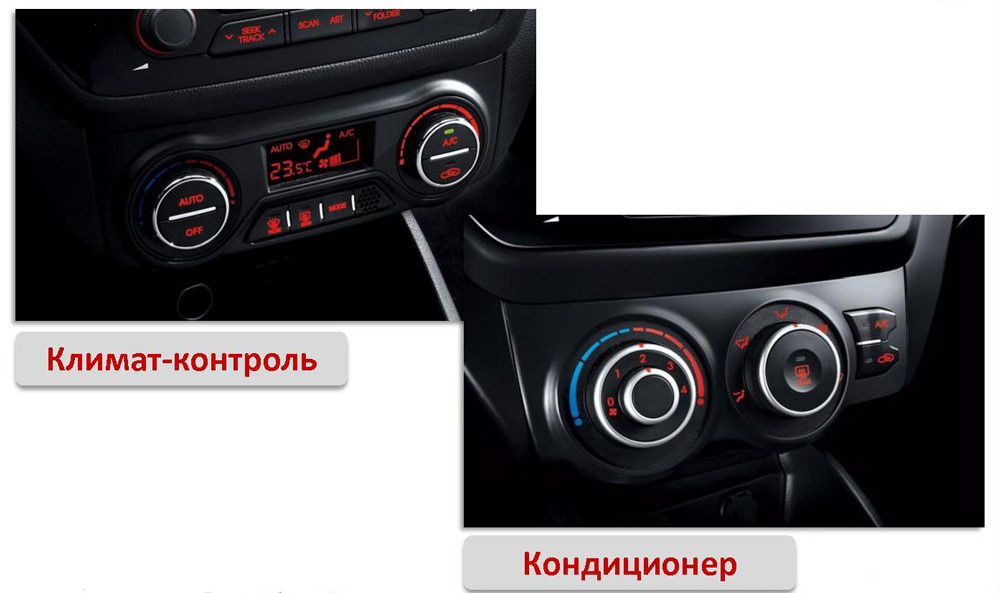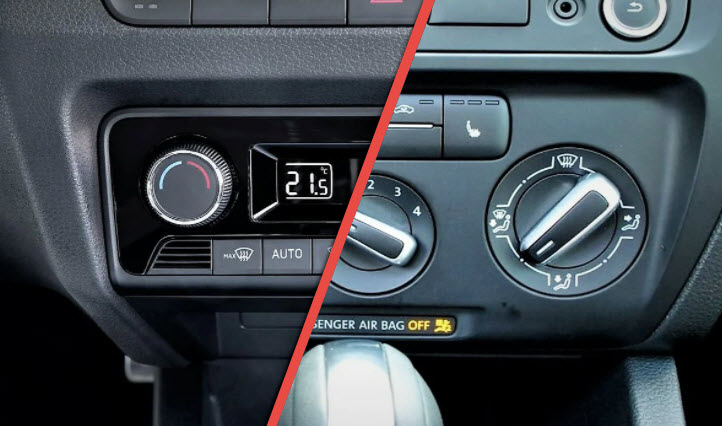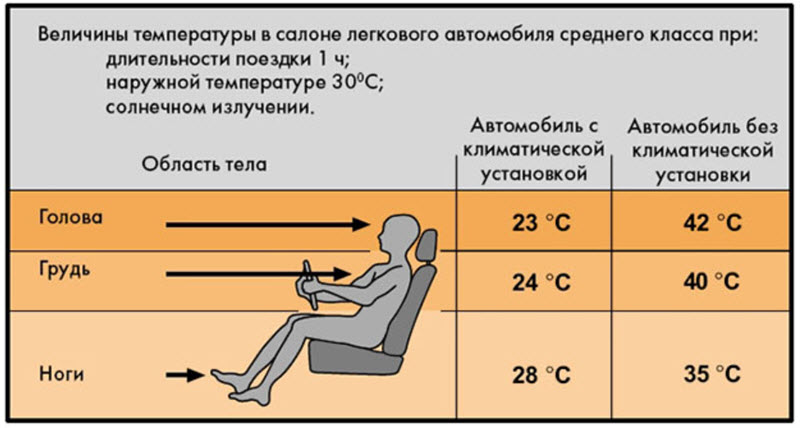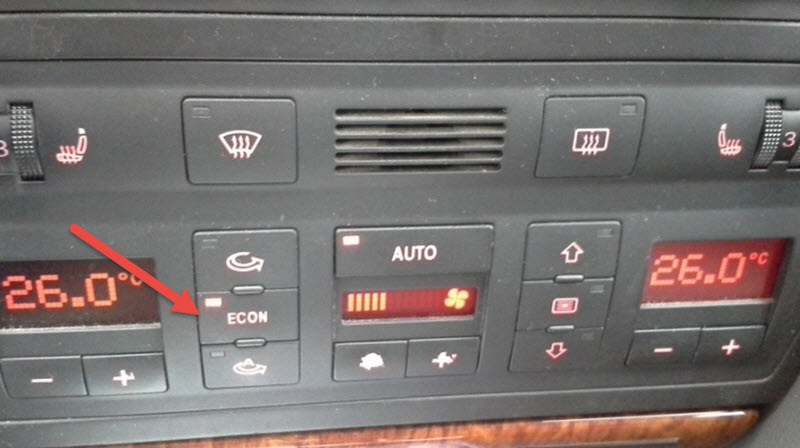
How climate control works in a car and how it differs from air conditioning
Content
Comfort in the car is provided not only by the properties of the suspension and the number of seat adjustments. All this will quickly fade into the background if the temperature in the cabin becomes unbearable, and no matter which sign on the Celsius scale.

Driving in such an atmosphere is simply not safe, the driver will lose concentration, and the passengers will further distract him from managing his complaints. In heavy traffic, one of the most important systems in a car is the climate system.
What is climate control in a car
The air conditioner in the car interior will soon celebrate its centenary, and the heater (stove) is even older. But the idea of combining all their features in a single installation is relatively new.

This is due to the need for widespread use of control electronics for automatic operation.
All three functions of the installation must work together:
- cabin air cooler (car air conditioner);
- heater, well-known stove;
- ventilation system, since the microclimate in the cabin requires closed windows and monitoring the renewal of air, for example, adjusting its humidity and pollution.
As soon as such an automatic system was developed and serially installed on cars, it was called climate control.
A good name fully reflects the essence of innovation. The driver no longer needs to control the handles of the stove and air conditioner, this will be monitored by automation.
Types of systems
The sources of heat and cold are quite traditional, these are the air conditioner evaporator and the heater radiator. Their power is always sufficient and few people are interested in numerical terms. Therefore, the consumer qualities of the units are classified according to the number of temperature control zones in the cabin.
The simplest systems single zone. The internal space is the same for them, it is understood that the climatic preferences of the driver and passengers are the same. Adjustment is made on one set of sensors.

Dual zone systems separate the driver and front passenger spaces as individually adjustable volumes. In automatic mode, the temperature for them is set by separate knobs or buttons with the corresponding indication.
It is not always possible to heat the driver, while freezing the passenger, but the temperature difference is quite significant, the more expensive and more complex the car, the greater it can be.
Further expansion of the number of regulation zones usually ends with four, although there is nothing to stop them from doing more.
Three-zone the regulator allocates the rear seat completely, and four-zone provides separate regulation for the right and left passengers of the rear compartment. Naturally, the installation becomes more complicated and the price of convenience increases.
Differences between climate control and air conditioning
The air conditioner is much simpler in terms of control, but just as difficult to set up. The driver has to manually adjust the temperature, speed and direction of cold air flows.
At the same time driving and the car as a whole. As a result, you can be distracted from the road and get into an unpleasant situation. Or forget to adjust the temperature and quietly catch a cold in a strong draft.


Climate control does not require all this. It is enough to set the temperature on the display for each of the zones, turn on the automatic mode and forget about the existence of the system. Unless at the very beginning to give preference to flows for glazing, but many systems themselves cope with this.
Climate control device
In a single unit there is everything necessary for heating and cooling the air:
- a heater radiator in which engine coolant at a high temperature circulates;
- an air conditioner evaporator, approximately the same radiator, in operating mode having a refrigerant temperature of about zero degrees;
- a fan driven by a variable speed electric motor and creating a general air flow through the radiators;
- system of air ducts and automatic shutters;
- interior air filter, often with carbon and anti-allergic cleaning;
- control device with a remote control, sensors and information displays.


Air can be drawn in from outside or inside the passenger compartment (recirculation). The latter mode is useful in extreme outside temperatures or heavily polluted overboard.
The system can even monitor the outboard temperature and the amount of solar energy entering the cabin. All this is taken into account by the control device when automatically optimizing flows.
How to use the system
To turn on the climate control, just press the automatic operation button and set the desired fan speed. The temperature is set by mechanical or touch controls, after which it will be shown on the display. The electronics will do the rest.


If desired, you can forcibly turn on the air conditioner, for which there is a separate button. This is useful when the temperature is low but the humidity needs to be reduced. The evaporator will condense and take away some of the water.
Systems in different cars are different, other control buttons can be used. For example, forced redistribution of flows up or down, recirculation control, and so on.


Watch this video on YouTube
What are the Econ and Sync buttons
The functionality of the special Econ and Sync keys is not entirely clear. They are not available on all systems. The first of them serves to optimize the operation of the air conditioner when the car has a lack of power or it is necessary to save fuel.
The compressor clutch opens more often, and its rotor stops loading the engine, and the idle speed drops. The efficiency of the air conditioner is reduced, but such a compromise is sometimes useful.


The Sync button means the synchronization of all zones of the multi-zone system. It turns into a single zone. Management is simplified, there is no need to set the initial data for all allocated spaces.
Advantages and disadvantages
The advantages of climate control are known to everyone who used it:
- it is not the driver who monitors the weather in the car, but a complex of precise sensors that promptly send commands to all changes in external conditions;
- the temperature is set once, it does not need to be manually adjusted as the interior warms up or cools down;
- flow directions are selected in an optimal way, there are no drafts;
- constant operation of coolers and heaters in the optimal mode significantly saves fuel consumption;
- Unbeknownst to the driver, additional devices are switched on and off if they are installed, for example, electric heaters in especially economical vehicles with low internal engine warm-up.
The disadvantage is the increased complexity and high cost of the equipment. It is also difficult to understand it in case of failure; qualified personnel will be required.
Nevertheless, almost all cars are equipped with just such automatic temperature controllers in the cabin, rare exceptions remain only in the most basic configurations of the most budget models. The difference is only in the complexity of the equipment and the number of sensors and air ducts with automatic dampers.
